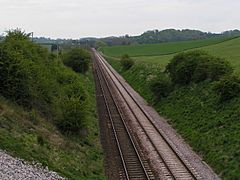Laycock Railway Cutting facts for kids
| Site of Special Scientific Interest | |
 |
|
| Area of Search | Somerset |
|---|---|
| Coordinates | 50°59′24″N 2°27′36″W / 50.9901°N 2.4601°W |
| Interest | Geological |
| Area | 1.3 hectares (0.013 km2; 0.0050 sq mi) |
| Notification | 1993 |
Laycock Railway Cutting is a special place in Somerset, England. It's officially known as a Site of Special Scientific Interest (SSSI). This means it's protected because it has very important natural features.
This particular SSSI is important for its geology. It covers about 1.3 hectares, which is roughly the size of two football fields. It was recognized as a special site in 1993.
Why is Laycock Railway Cutting Special?
Laycock Railway Cutting is one of the best places to see a type of rock called 'Fuller's Earth Rock'. This rock formed during a time in Earth's history called the Bathonian period. This period was part of the Middle Jurassic era, which was about 168 to 166 million years ago!
Amazing Ammonite Fossils
At Laycock, you can find many Ammonite fossils. Ammonites were ancient sea creatures with spiral shells, similar to modern-day nautiluses. The ammonites found here are special because they help scientists understand specific time periods within the Middle Bathonian. These periods are called the Morrisi and Subcontractus zones.
Finding ammonites from these specific time periods is very rare in Britain. Because of this, the fossils at Laycock are important for understanding the Earth's timeline around the world.
Understanding Earth's History
The rocks and fossils at Laycock Railway Cutting help scientists in two main ways:
- Lithostratigraphy: This is about studying the different layers and types of rocks.
- Chronostratigraphy: This is about figuring out the age of rock layers and the timeline of Earth's history.
Because Laycock shows both these features so well, it's a key location for anyone studying the Bathonian period in Britain. It helps us piece together what the world was like millions of years ago.

